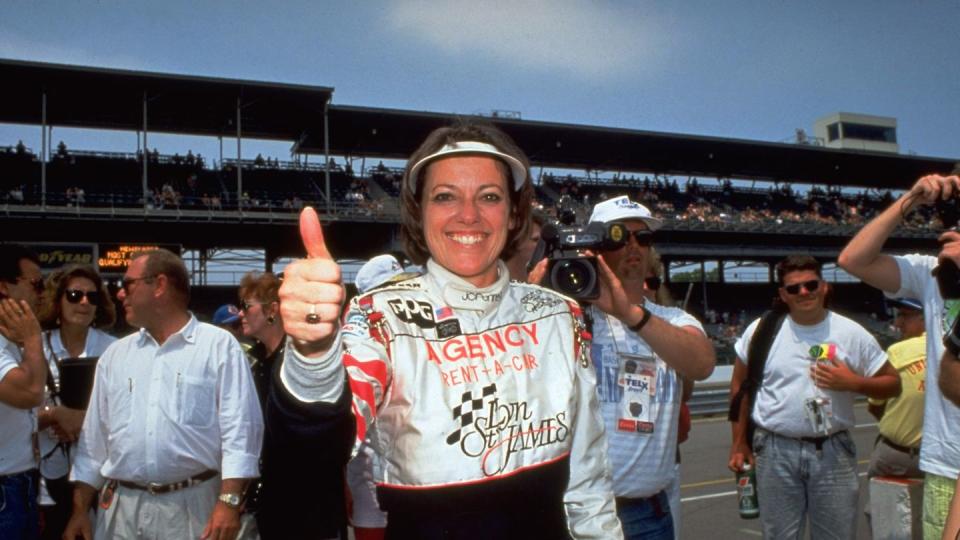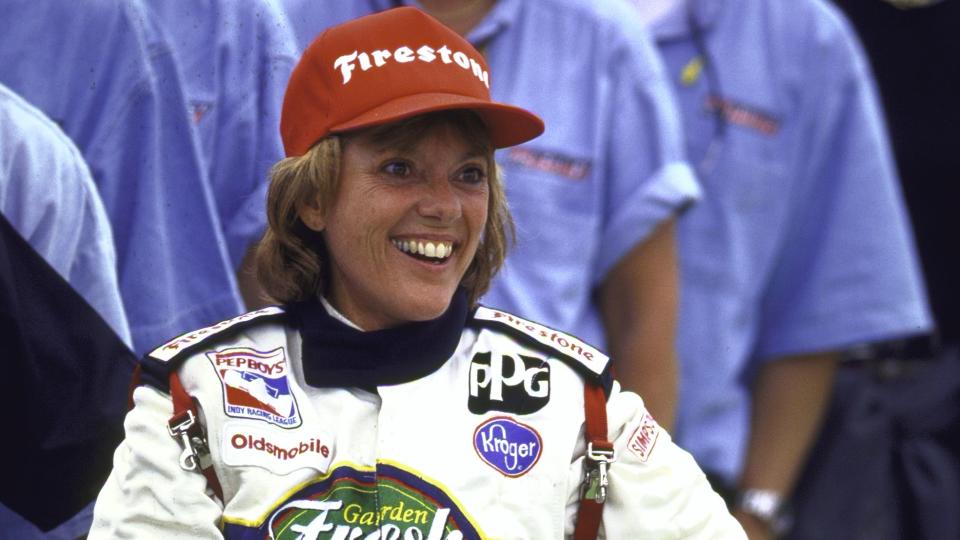Lyn St. James Sees New Wave of Women Racers in NASCAR on Horizon

Since Lyn St. James became the first woman to win rookie honors in the 1992 Indy 500, women have moved into every facet of the motorsports industry.
NASCAR, however, has not had a women on the starting grid in the Cup Series since Danica Patrick was a regular in the series six years ago.
"I’m not trying to change the face of motorsports, I’m trying to grow the sport," says St. James, who will celebrate her 50th year in motorsports in 2024.
Women in Motorsports North America co-founder Lyn St. James, who won rookie honors in the 1992 Indianapolis 500, says there's a reason NASCAR hasn't seen an influx of women into the Cup Series since Danica Patrick was last a regular in the sport in 2017.
There's a reason.
“Almost every gal that came through my driver development program for 20 years aspired to go to NASCAR, but I think their background didn’t often support that,” St. James says. “In other words, their background didn’t get them ready to go stock car racing. That’s changing now … if you look at the ARCA Series or the weekly series.”
St. James believes the time is right for women drivers to break through in the sport.
“We have enough numbers, and we have talent within those numbers,” St. James says. “We have more interest in wanting to support the talent. We just have to be careful and strategic, be willing to make the investment and then pay attention to supporting that investment.
“Within society, women are getting more attention, they’re getting more support, there’s more of them succeeding in society. I think there is a tipping point right now.”
However, St. James is concerned about those attempting to stop groups working for the advancement of women in motorsports. The conservative group America First Legal has asked the Equal Employment Opportunity Commission to investigate NASCAR and Rev Racing for “illegal discrimination against White, male Americans.”
During the past year, AFL has accused more than a dozen companies of having discriminatory diversity, equity, and inclusion programs.
“We’re not denying others, we’re expanding the ones that have been denied,” St. James says. “I think if … we have a unified voice, and we speak loudly, and it isn’t just about women in motorsports, it’s about women in sports … this is what makes society better.”
Since St. James became the first woman to win rookie honors in the Indy 500, women have moved into every facet of the motorsports industry. In addition to driving, women are now executives in sanctioning bodies and at race tracks, race engineers and strategists, over-the-wall crew members, team owners and supervisors of marketing and public relations programs.

St. James is often introduced as the person who is trying to change the face of motorsports, but she quickly says that’s a fallacy.
“I’m not trying to change the face of motorsports, I’m trying to grow the sport,” says St. James, who will celebrate her 50th year in motorsports in 2024.
That growth starts with children and St. James points to the NHRA’s Junior Dragster program as a key in the number of females in drag racing. Sara Walker, senior manager of NHRA Sportsman Racing, says they have started Junior Street, a category for teenagers 13 to 16 years old. The program allows teenagers to race a street car on a dragstrip with a parent in the passenger seat. Walker says the female-to-male ratio in her NHRA category is 50-50.
Danielle Frye, who directs USAC’s quarter-midget racing division that’s sanctioned by the NASCAR Youth Series, has 1,800 registered drivers across 60 clubs in the United States. She says 423 of those registered drivers are females and 73 of them have younger siblings that are females. The national champion this year in the Junior 150 Class in the dirt series is a female.
St. James believes a universal program for youth racers is needed to teach basic racing skills. They would then realize that ahead of them is what St. James describes as “the candy store” and they could pick the “kind of candy (they) want”, IndyCar, IMSA, or NASCAR.
During NASCAR’s State of the Sport address earlier this month, chief operating officer Steve O’Donnell said the sanctioning body had hired Joey Denowitz to work on the sport’s ladder system. O’Donnell described it as a “huge focus” for NASCAR. There currently isn’t a clear path for a young driver, male or female, to reach stock car racing’s top series.
“The majority of the short-track racers are veteran short-track racers. They aren’t going anywhere,” St. James says. “They’re just as happy as a lark to be the king of their little fiefdoms. When they see anybody, female or male, coming through … that they know is just on their way, they’re gonna show … those kids what they’re made of. They’re not willing to share their turf. They’re intentionally making sure (they) fail. We’ve had many instances of selective targeting.
“There is some really bad behavior at some of these short tracks and it has nothing to do with women. So, it’s hard for a young driver, male or female, but particularly a female, to decide or define (the path they need to follow).”
Another issue facing women who aspire to NASCAR’s top-level is the limited number of seats and the low turnover rate. IndyCar seats are also limited even though nine women have competed in the Indianapolis 500 since Janet Guthrie became the first in 1977. More seats are available in sports car and drag racing.
“It’s a tough sport. It’s a tough business, and once you have career aspirations it becomes a business,” St. James says. “If you’re racing to create a record that is going to enable you to have a career, that means there’s going to be business exchanges all along the way. You have to study the business of the sport as much as you study the technology, and as much as you study the skill sets.”
Learning the business doesn’t mean simply acquiring sponsorships, it includes becoming familiar with race track owners, promoters, the records at those tracks and the various teams’ records.
“Pay attention to what is happening around you,” St. James says.

 Yahoo Autos
Yahoo Autos 